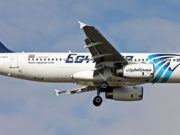
The following information provides an awareness of problems that might be avoided in the future. The information is based on final reports by official investigative authorities on aircraft accidents and incidents.
 Jets
Jets
Crossed Wires
Boeing 787-8. Substantial damage. No injuries.
After an early morning landing at London Heathrow Airport on July 12, 2013, the 787 was towed to another stand in preparation for a scheduled flight later that day. The ground handling agent turned off ground power at the stand’s control box but did not disconnect the power cables from the aircraft. However, an engineer aboard the aircraft confirmed that ground power no longer was available to the 787.
The engineer secured the aircraft and disembarked at 0730 local time. About eight hours later, an employee in the air traffic control (ATC) tower saw smoke emanating from the aircraft and activated the crash alarm.
About one minute after the alarm was sounded, aircraft rescue and fire fighting (ARFF) personnel arrived and sprayed water and foam on the aircraft. “One fire fighter removed the power umbilical cables from the aircraft as a precaution,” said the report by the U.K. Air Accidents Investigation Branch (AAIB).
ARFF personnel encountered thick smoke inside the aircraft and saw signs of a fire between two overhead luggage bins near the rear of the cabin. They removed some ceiling panels and doused the fire with water.
There were no injuries, but “the aircraft suffered extensive heat damage in the upper portion of the rear fuselage, in an area coincident with the location of the emergency locator transmitter (ELT),” the report said. “The absence of any other aircraft systems in this area containing stored energy capable of initiating a fire, together with evidence from forensic examination of the ELT, led the investigation to conclude that the fire originated within the ELT.”
Investigators found wires crossed and trapped beneath the ELT battery compartment cover plate. They concluded that contact between one of the wires and the cover plate likely created a short circuit that caused one of the five cells in the lithium manganese dioxide (nonrechargeable lithium metal) battery to discharge rapidly.
“Neither the cell-level nor battery-level safety features prevented this single-cell failure, which propagated to adjacent cells, resulting in a cascading thermal runaway, rupture of the cells and consequent release of smoke, fire and flammable electrolyte,” the report said.
The flames caused the resin within the composite fuselage crown near the vertical stabilizer to decompose and ignite. The slow-burning fire continued to propagate after the energy from the battery thermal runaway was exhausted, the report said.
AAIB safety recommendations based on the investigation led to several industry actions, including operator bulletins by Boeing and Honeywell, the ELT manufacturer, calling for inspections of 787 ELT battery wiring. The bulletins subsequently were incorporated in airworthiness directives issued by U.S. and European aviation authorities.
The U.S. Federal Aviation Administration (FAA) and other aviation authorities also launched a safety review of lithium-powered ELTs in other aircraft models and the certification standards for the devices.
Approach Briefing Omitted
Boeing 737-400. Minor damage. No injuries.
En route on a scheduled flight from Jakarta to Pontianak, Indonesia, the afternoon of Oct. 19, 2012, the flight crew learned from ATC that weather conditions at the destination included heavy rain, thunderstorms, a 1,700-ft ceiling, 6 km (4 mi) visibility and surface winds from 270 degrees at 5 kt.
The pilots selected a higher autobrake setting (medium) but otherwise did not conduct an approach briefing or review their landing distance calculations before they were vectored to join the instrument landing system approach to Runway 15, according to the report by the Indonesian National Transportation Safety Committee (NTSC). The crew reported the runway in sight at 800 ft and were cleared to land. “While on final approach, the pilot noticed on the navigation display that the wind was calm, while on short final the wind changed and the pilot felt the aircraft shaking,” the report said.
Indicated airspeed was 13 kt above the reference landing speed at 50 ft, and a 10-kt tail wind increased groundspeed further to 163 kt. “This particular condition was classified as an unstabilized approach and requires the pilot to go around,” the report said.
The crew continued the approach, and the 737 bounced once on touchdown. The pilot deployed the thrust reversers but did not feel the aircraft decelerate. He disengaged the autobrake system and applied manual braking. Investigators determined that the deceleration rate then began to decrease.
The 737 stopped with its main landing gear on the edge of the departure end of the 7,382-ft (2,250-m) runway, and the nose landing gear sank into soft terrain. No one was hurt, and ARFF personnel assisted the 166 occupants in deplaning.
Damage to the main landing gear tires and white tire marks on the runway indicated that the aircraft had experienced reverted-rubber hydroplaning on the wet runway.
The NTSC concluded that the probable cause of the accident was that “the absence of an approach briefing, particularly on reviewing landing distance, might have decreased the pilot’s [situational] awareness.”
Wrong Handle
Cessna Citation 550. Minor damage. No injuries.
The pilot said that he flew the final approach to Key West (Florida, U.S.) International Airport at 106 kt and that the Citation touched down at 95 to 100 kt and 800 ft (244 m) from the approach threshold of Runway 09 the afternoon of Nov. 3, 2011.
“At touchdown, he extended the speed brakes, and, after traveling another 800 feet, he began to apply wheel braking, but the brake pedals felt ‘hard’ and would not move,” the report from the U.S. National Transportation Safety Board (NTSB) said. The copilot also attempted unsuccessfully to apply manual braking.
“The pilot felt that he had to stop and could not go around,” the report said. He engaged the emergency braking system but found that it, too, was ineffective. “Examination of airport security camera images and deceleration values (determined by using time, distance and velocity calculations) indicated that the airplane’s deceleration was consistent with a lack of braking,” the report said.
The Citation ran off the end of the 4,801-ft (1,463-m) runway and came to a stop after entering a 340-ft (104-m) engineered material arresting system (EMAS). The overrun resulted in minor damage to the nose landing gear, left main landing gear door and forward fuselage, but there were no injuries among the five occupants.
“Examination of the normal hydraulic braking system and antiskid system did not reveal any malfunctions or failures that would have precluded normal operation of the brakes,” the report said. “Examination of the cockpit revealed that the T-handle for the emergency [landing] gear extension system had been activated. This handle is located immediately to the right of the emergency braking handle and was most likely pulled during the incident landing instead of the emergency brake handle.”
The report noted that the EMAS had been installed to meet FAA requirements for a runway safety area (RSA) because the proximity of a mangrove swamp precluded a standard 1,000-ft (305-m) RSA off the end of Runway 09.
 Turboprops
Turboprops
Battered by Hail
Beech King Air F90. Substantial damage. No injuries.
The aircraft was en route from Beira, Mozambique, to Lanseria, South Africa, the afternoon of Nov. 28, 2013, when the pilot requested clearance from ATC to alter course to circumnavigate a thunderstorm.
The controller approved the deviation and told the pilot to fly directly to Lanseria when able. After flying about 15 nm (28 km), he turned toward the destination.
“Although the aircraft was equipped with weather radar and the pilot utilised it, he miscalculated the size of the storm and turned too soon,” said the report by the South African Civil Aviation Authority. “The aircraft experienced heavy wind shear and hail.
“Once the aircraft was out of the thunderstorm, the pilot advised radar control that his aircraft had suffered hail damage.” He diverted to Johannesburg and landed the King Air without further incident.
Examination of the aircraft revealed hail damage to the wing leading edges, fuselage, propeller spinners and engine exhaust stacks.
Life Limits Neglected
Fairchild Metro 3. Minor damage. No injuries.
Night visual meteorological conditions prevailed as the Metro neared Minneapolis-St. Paul (Minnesota, U.S.) International Airport on a cargo flight on Nov. 9, 2012. The pilot confirmed that all three landing gear indicator lights were green before landing the airplane.
Shortly after touchdown, the left main landing gear collapsed, and the airplane veered off the left side of the runway. Examination of the airplane revealed two loose electrical connections on the landing gear hydraulic power pack and “several anomalies in the hydraulic shuttle valve,” the NTSB report said.
Investigators determined that the power pack had not been replaced at the life limit established by the manufacturer. “It is likely that the hydraulic issues allowed for a movement in the landing gear shuttle valve, which resulted in an uncommanded gear unlock and subsequent collapse of the left main landing gear,” the report said.
Mistaken Landing Site
Saab 340B. No damage. No injuries.
The weather was clear, but daylight was fading as the aircraft neared Newcastle Airport in Williamstown, New South Wales, Australia, during a scheduled flight the evening of Nov. 8, 2012. The airport tower controller cleared the flight crew to conduct a right traffic pattern to Runway 12.
The captain previously had experienced difficulty in sighting the airport during visual approaches from the south and was guiding the first officer, the pilot flying, toward buildings he perceived as associated with the airport, according to the report by the Australian Transport Safety Bureau (ATSB).
The buildings actually were on a coal-storage facility 6 nm (11 km) south of the airport. The facility had ground structures and lighting features similar to the airport, as well as a long line of coal aligned almost identically with Runway 12.
The first officer became increasingly unsure of the aircraft’s position as he was guided onto a right downwind leg and a right base leg, and transferred control to the captain. The captain, who “could not see the runway” but “had formed a strong belief that they were in the airport environment,” continued to descend while establishing the aircraft in landing configuration, the report said.
Meanwhile, the approach controller had continued to monitor the aircraft’s progress on radar and had become concerned about its position and track. He called the airport traffic controller and suggested that he query the crew about their intentions. “In response to the [tower] controller’s query if they were still visual, the crew responded that they had just ‘lost’ the runway and were continuing the right turn,” the report said.
Using binoculars, the tower controller spotted the aircraft and advised the crew that they were 6 nm south of the airport. “When told they were not at the airport, the captain immediately requested radar vectors to resolve the uncertainty,” the report said.
The controller suggested a heading toward the airport and increased the intensity of the runway lights. The crew subsequently landed the Saab without further incident.
“This occurrence highlights the possibility of crews misidentifying ground features for the airport environment during visual approaches, especially in conditions of poor light,” the ATSB said. “To avoid misleading visual cues during visual approaches, crews should confirm that they have correctly identified and are tracking to the intended destination by cross-checking with the aircraft’s navigation equipment.”
 Piston Airplanes
Piston Airplanes
Refueled With Jet-A
Cessna 421B. Substantial damage. One serious injury, two minor injuries.
After a previous flight, the pilot had asked the fixed-base operator (FBO) in Lufkin, Texas, U.S., to refuel the airplane, but he did not observe the fueling. “The FBO employee who fueled the airplane … mistook it for a similar airplane that uses Jet-A [turbine engine] fuel,” the NTSB report said. “He brought the Jet‑A truck over and fueled the airplane.”
The report said that the fuel nozzle on the Jet-A truck had been changed to facilitate the fueling of military helicopters that frequented the airport. They were round and smaller than the J-shaped nozzles used to dispense Jet-A, according to the report.
Moreover, the airplane’s filler ports had not been fitted with restrictors, as required by an airworthiness directive intended to prevent the misfueling of piston aircraft with turbine fuel.
The next morning — April 17, 2015 — the pilot signed a receipt showing that the airplane had been fueled with 53 gal (201 L) of Jet-A. The pilot said that during his preflight inspection of the airplane, the fuel samples appeared to be blue, like 100LL aviation gasoline, and that no anomalies occurred during the engine run-ups.
However, shortly after takeoff, he noticed a slight vibration and decreased climb performance. Both engines lost power as the 421 climbed through 2,100 ft. The pilot was seriously injured and his two passengers sustained minor injuries during the subsequent forced landing on a highway median.
Landing Checklist Neglected
Piper Chieftain. Minor damage. No injuries.
The pilot flying was receiving pilot-in-command supervision by another pilot during a charter flight with seven passengers to Townsville, Queensland, Australia, the afternoon of Jan. 9, 2015. During a visual approach, both pilots conducted the pre-landing checks from memory, rather than using the checklist, said the ATSB report.
The pilot neglected to extend the landing gear. “The supervising pilot confirmed the mixture, fuel pumps and landing lights had been set correctly, and assumed the rest of the checks had been similarly completed,” the report said.
Neither pilot recalled hearing the landing gear warning horn, but investigators later found that the system was operational.
After the aircraft was flared for landing, both pilots sensed that the landing gear did not touch the runway as expected. The pilot initiated a go-around at the same time the supervising pilot called “go around.”
A radio antenna separated when the fuselage scraped the runway, but the pilots were able to complete the go-around and land the Chieftain without further incident.
Miscalculated Fuel Reserve
Piper Aztec. Substantial damage. No injuries.
The pilot departed from Destin, Florida, U.S., with a partial fuel load, estimating that the Aztec would have about 4 gal (15 L) of fuel in its tanks after landing in Quincy, Illinois, on Oct. 26, 2014.
“The pilot [later] acknowledged that he failed to account for the 6.8 gallons [26.0 L] of unusable fuel within the fuel system,” the NTSB report said.
The Aztec was descending through 3,500 ft about 7 nm (13 km) from the destination airport when the right engine lost power. “The pilot feathered the right propeller, secured the right engine and continued toward the planned destination,” the report said. “Shortly thereafter, the left engine lost total power, and the pilot feathered the propeller and secured the engine.”
The pilot was unable to extend the landing gear normally and did not activate the emergency gear-blowdown system before conducting a forced landing in a soybean field. The Aztec was substantially damaged, but the pilot and his three passengers escaped injury.
 Helicopters
Helicopters
Blinded by a Movie Light
Bell 206B. Substantial damage. Three fatalities.
The JetRanger was engaged in the filming of a movie sequence at a ranch in Acton, California, U.S., the night of Feb. 10, 2013. “During the first flight … several of the pilot’s comments indicate that he was trying to be amenable to the production company’s requests, [but] he repeatedly remarked on the limited visibility and the brightness of a flexible light pad affixed to the center windshield frame in the cockpit,” the NTSB report said.
Before the second flight, in which the helicopter was to ascend to a plateau from an unlighted riverbed, the cameraman in a rear seat showed the actor, who was in the left front seat, how to operate the light pad.
The light was set to its lowest brightness level for takeoff. While the helicopter was being maneuvered over the riverbed, the actor continued with scripted dialogue for about a minute until he was interrupted by the pilot, who said that he needed the light pad turned off.
“The camera operator acknowledged him and informed the actor to turn off the light by pressing a button twice,” the report said. “The actor cycled through the light’s settings and eventually turned it off while the pilot stated ‘okay, okay, I can’t ….’ The camera operator interrupted, saying ‘pull up, pull up.’”
All three occupants were killed when the JetRanger struck the riverbed. The NTSB concluded that the probable cause of the accident was “the pilot’s decision to conduct a flight in dark night conditions with an illuminated cockpit light that degraded his visibility and his ability to identify and arrest the helicopter’s descent while maneuvering.”
Rushed Into Clearing
Robinson R44. Substantial damage. No injuries.
The pilot said that he radioed his position regularly while flying the landing pattern at Beaumont, Texas, U.S., the evening of Sept. 15, 2014. While flaring to land at midfield, he heard an airplane pilot radio that he was departing on the same runway.
“The [R44] pilot attempted to depart the runway area for the taxiway,” the NTSB report said. “As he turned the helicopter toward the taxiway, he felt it ‘swing hard and turn,’ then begin to spin. The pilot stated that he lost control and landed hard, crushing the skids.”


